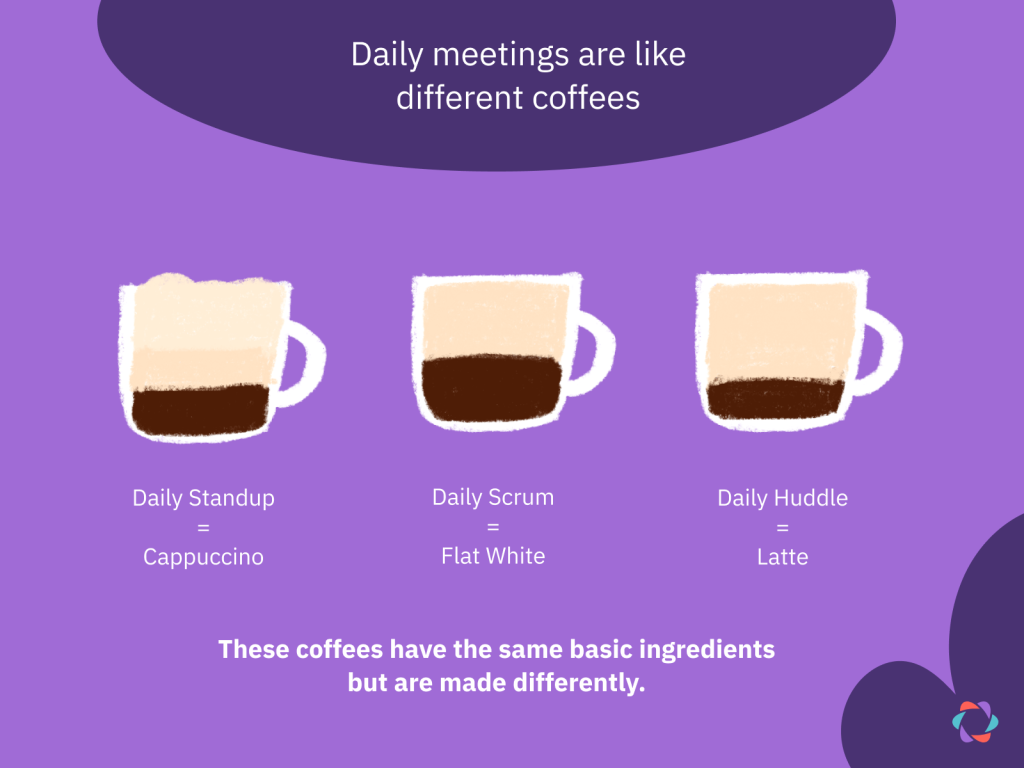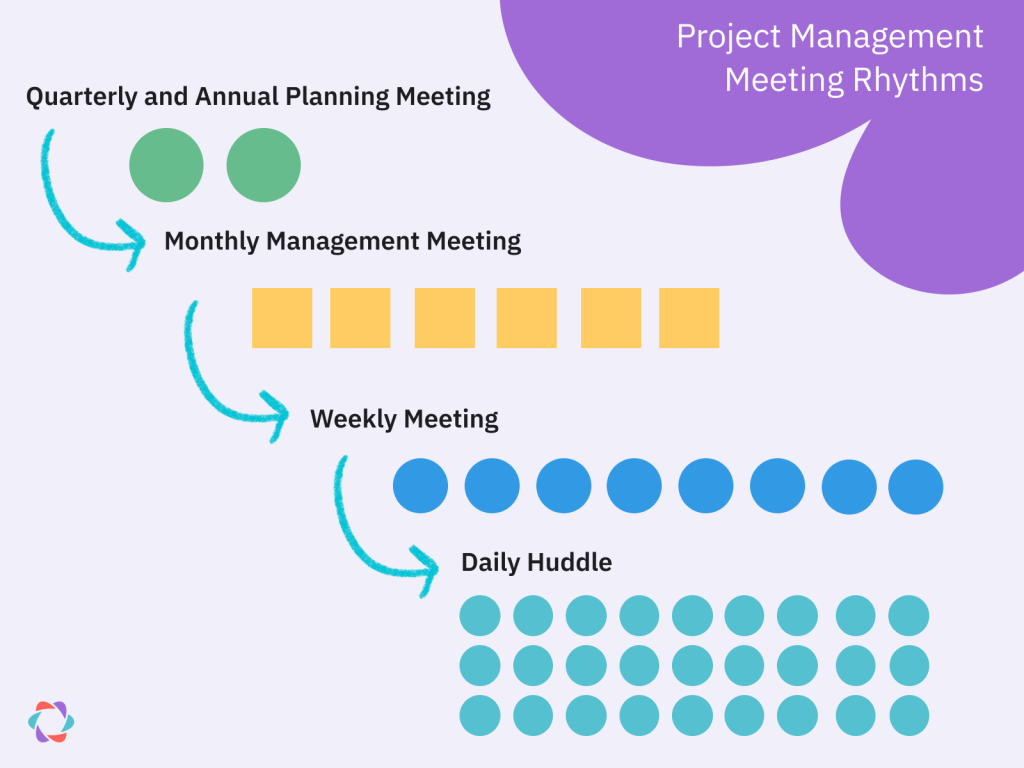Standup Meetings 101
Get a pulse on your team and your goals, and discuss what’s important—async or in real time.
Standup meetings are one of the most commonly run meetings by teams around the world. In fact, 87% of Agile software teams claim they run daily standup meetings. Despite that, the meetings often don’t get much love from the people who attend them.
We’ve created a complete overview of the daily standup meeting for you. We differentiate the daily standup from other similar meetings, list different formats, coaching questions, and talk about the difference between sync and async standups.
What is a daily standup meeting?
Daily standups are short, structured meetings used in agile project management. Standups last no more than 15 minutes and usually just 5-10 minutes. They are meant to keep everyone on the same page and ensure that all team members are aligned and able to work without blockers.
Teams of different shapes, sizes, and from different industries hold a 15-minute daily standup every workday. The meeting’s purpose is to clarify the day’s work, adjust plans, and engage in quick problem-solving.
The practice of holding a daily team meeting is often attributed to American business magnate John D. Rockefeller. Rockefeller would have lunch every workday with the leaders of his company, Standard Oil.
The term “standup” comes from the idea that when everyone is standing, it encourages the team to keep the meeting short.
Alongside the daily standup, there are two similar meetings that we’ll also cover in this guide: the Daily Scrum and the Daily Huddle. Most people use these terms interchangeably, yet there are some important distinctions, which we cover below.

The Daily Standup
The daily standup is the term most people are familiar with when it comes to daily meetings. It doesn’t have a fixed format and it doesn’t originate in any specific management theory or agile framework. In terms of its common practices, it lives between the Daily Scrum and the Daily Huddle.
“Daily Standup” is often used as a catch-all term for daily meetings that aren’t explicitly the Daily Scrum or the Daily Huddle. In our definition, agile teams that don’t follow Scrum hold daily standups.
Nonetheless, the daily standup format takes inspiration from XP, Scrum, and other daily meeting approaches. Every team has a different way of running Daily Standups, and since there’s no clear origin for the practice, there are also no clear rules.
Daily Standup characteristics:
- Practiced by various teams, including those that follow agile methodologies other than Scrum.
- Usually timeboxed to ~15 minutes.
- Follows a format and rules created by the team..
- Typically focuses on unblocking each other and figuring out how to reach a goal or complete work.
- Generally does not involve reporting on metrics.
- Agenda or template can be built from any questions you choose.
Try the Daily Standup when:
- You want a free-form daily meeting outside the Scrum framework
- You want to use your daily meeting primarily to unblock one another
The Daily Scrum
Scrum teams practice a variation of the daily standup called the Daily Scrum. It’s the most restrictive approach because the Daily Scrum meeting is officially defined and prescribed with dos and don’ts in the Scrum Guide.
Daily Scrums are held every day of a development team’s sprint at the same place and the same time. Older versions of the Scrum Guide used to prescribe 3 questions to structure the Daily Scrum. Now, teams can structure the meeting however they like.
Daily Scrum characteristics:
- Held every day of a Sprint.
- Held at the same time and place every day.
- Timeboxed at 15 minutes.
- Only for the developers of a Scrum team.
- No “management” participation
Try the Daily Scrum when:
- You are working in Sprints and have a defined Sprint Goal
- You are explicitly working within the Scrum framework
💡 Read more about the attendees, their roles, and best practices in Daily Scrum: Complete Beginner’s Guide.
The Daily Huddle
All kinds of teams and companies hold daily huddles, including organizations that don’t follow agile methods and principles.
It’s the least restrictive daily meeting because the term has been around the longest with no official definition (although the book Mastering the Rockefeller Habits popularized and defined the term somewhat).
In most organizations, the huddle is a daily pulse check on longer-term goals and the progress towards them.
Software teams rarely use the Daily Huddle meeting type. It’s more often used by traditional organizations or environments where touching base on metrics is important. For example, at a hotel where all hotel staff come together to discuss what’s on the agenda for the day. Or a car showroom where the Daily Huddle may be used to reiterate sales targets and track progress towards them.

Daily Huddle characteristics:
- People have used the term “daily huddle” to refer to a daily team meeting since the 1930s and 1940s.
- Teams often use daily huddle meetings to track metrics they’ve set in weekly, monthly, and quarterly meetings.
- There are no rules on who can attend a daily huddle or the number of attendees the meeting can have.
- A typical question trio for daily huddles is “What’s up (in the next 24 hours),” “What are the daily metrics,” and “Where are you stuck?”
- It sometimes involves a discussion of metrics
- May include management participation
Use the Daily Huddle when:
- You want to come together as a team to discuss strategy or progress towards metrics
- You are not working in a Scrum or Agile software development team
- When you plan work on a daily basis
💡 Read more about typical agenda items, templates, and tips in Daily Huddle: Everything You Need For a Great Huddle Meeting.
Daily standup formats
A fresh daily standup format can be the difference between a gathering people dread and a meeting they find valuable.
Here are some examples of formats you can use to change the meeting’s agenda:
- Walking the board: With Walk the Board, the Sprint or Kanban board items drive the meeting agenda, not the attendees or a set of questions. Walking the board focuses more on the team and its work than on individuals, which is why some people rave about this standup approach.
- Daily wrap-ups: A daily wrap-up happens at the end of the day, so your work is still fresh in your mind. This format uses a set of open questions that are broad and optional, inviting variety and creativity while reducing the need for forced responses.
- Needs-based standups: Trigger your standup when you have enough blockers to justify one. This format blows apart the assumption that the clock and calendar dictate when a meeting happens.
- Asynchronous standups: With an async standup, team members can contribute updates when and where they want to. It’s a good option for distributed teams working in different timezones. Teams can customize the format of async standups as they like.Want to check out even more daily standup formats? Head over to 14 Daily Standup Formats to Try With Your Team.
What’s the difference between real-time and async standups?
Besides changing the agenda, you can also try running your daily standup differently than gathering in front of a board or on Zoom call.
Instead of holding your meeting in real time, you can switch to an asynchronous approach so that team members can contribute at a time that works for them.
Shifting to an async standup is especially beneficial for teams spread across many timezones – here are some of the benefits you can expect:
- 🌙 No meetings at odd hours for people in different timezones.
- 🕦️ Team members contribute at a time that suits their workflow and life.
- 🤗 Standups are more inclusive because introverts can share their ideas in a relaxed manner with time to think and without being put on the spot.
- 🧘🏽♀️ Contributions are more thoughtful since people have time to think before writing or speaking.
- 🔍️ Information is written down and becomes organized, linkable, and searchable.
When you opt for asynchronous standups, you’ll need a tool to support this approach. Parabol’s online standup tool saves your entire team hassle and time. You can share updates on your own time, set a cadence that suits your team, and see everyone’s contributions in one view.
Daily standup questions to prevent meeting fatigue
When you stick to a default pair of standup prompts day after day, team members may find themselves reciting the same answers over and again. Even worse, they stop listening to others while their minds are focused elsewhere.
To keep your daily standups fun and valuable, facilitators should have an arsenal of questions to mix things up when your sessions are about to go stale. But better prompts are just one aspect of improving standups. Knowing what to say during the meeting can further increase its effectiveness.
What questions should you ask in a standup meeting?
Previous versions of the Scrum Guide recommended three questions to ask during the Daily Scrum. The guide no longer prescribes these questions, but many teams – even those not practicing Scrum – still use them to structure their meetings.
What did you do yesterday?
What will you do today?
Are there any blockers or impediments preventing you from doing your work?
Instead of the three Scrum questions from the past, consider one of our 57 daily standup questions, like:
- What do we agree on doing today to ensure we reach the Sprint Goal?
- What can we finish today?
- What worries you about the Sprint or project?
- Are you working on anything that wasn’t planned? How is that affecting your workload?
- What are you NOT working on today? Why?
- Who has a blocker that needs resolving?
- Who has some time to help someone else?
- What animal best represents you today and why?
- What can we do next to move forward?
- What should we not do, stop, or change?
What to say in a standup meeting?
One big complaint about standups is that the meetings goon for too long because it becomes an occasion for complex problem-solving, long-winded discussions, status reports, or on-the-spot action.
For better standups, team members should think less about “what do I want to say?” and more about “what is important for my colleagues to hear?”.
We’ve outlined ten simple principles to help you craft better standup updates. Click each one for more details:
Dig deeper into daily standups with these resources
Here are some other standup resources you might find helpful!
